Samsung Epic 4G Review: The Fastest Android Phone
by Anand Lal Shimpi on September 6, 2010 5:28 PM EST- Posted in
- Smartphones
- Samsung
- Epic 4G
- Gadgets
- Mobile
The Fastest GPU in a Smartphone
One thing I’ve learned over the past several years is that if you’re not the original manufacturer of something and are simply a glorified parts assembler, you generally have no clue how to do something right. There are obvious exceptions (Apple appears to be doing well), but this characterization applies to a lot of companies in the consumer electronics industry. They buy chips and parts from various suppliers, do a little bit of industrial design and generally don’t have the engineering know-how to deliver an optimized product into the marketplace.
Samsung is quite the opposite. Samsung is a DRAM manufacturer, a NAND flash manufacturer, and an application processor manufacturer. Samsung is responsible for the DRAM, NAND and silicon that goes into every iOS device sold by Apple. The company knows a thing or two about engineering.
The SoC inside the Epic 4G and other Galaxy S parts is called Hummingbird. It’s a 45nm SoC that implements a standard ARM Cortex A8 running at 1GHz and a PowerVR SGX 540 GPU. Despite Samsung’s experience in silicon manufacturing, it’s not much of an architecture/design company so we do see a lot of IP licensing within Hummingbird.
In this capacity Samsung is no different than TI, but what really sets Hummingbird apart is its GPU. Licensed from Imagination Technologies, the PowerVR SGX 540 is a significant improvement over the 530/535 in use in the iPhone, iPad and Motorola’s Droid X.
The SGX 530 has two USSE pipes and a single texturing unit. The 535 adds a second texturing unit, and the 540 adds another two USSE pipes. It’s unclear what clock speed the SGX 540 runs at inside Hummingbird, but I’d expect it’s somewhere near the 200MHz of the 535 in TI’s OMAP 3630.
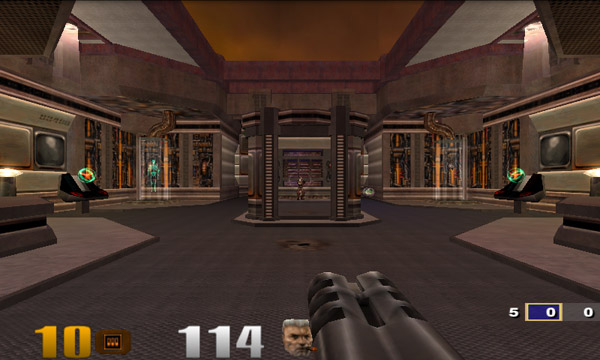
Quake 3 Arena running on the PowerVR SGX 540
The added execution hardware does incur a power penalty, however Imagination lists it as less than double the SGX 535.
The performance improvement is tangible. Samsung’s Hummingbird faster in 3D games/apps than any other SoC used in a smartphone today:
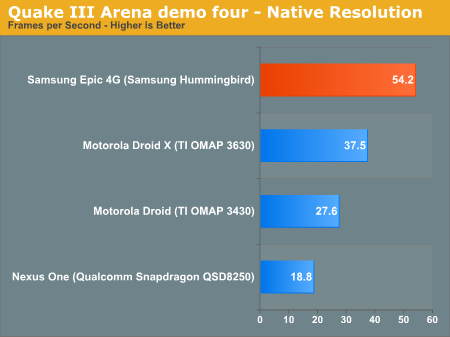
Under Quake III we saw a 44.5% increase in performance over the Droid X. Compared to Qualcomm's Snapdragon, performance improves by nearly 2x.
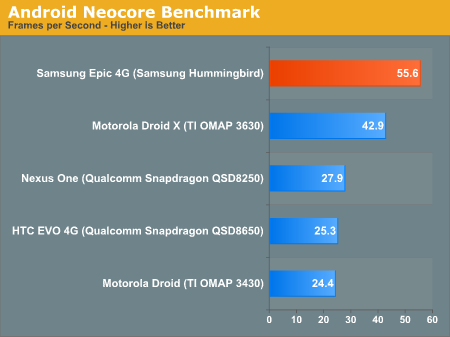
Even in Qualcomm's own 3D test, the PowerVR SGX 540 is more than twice as fast as the Snapdragon. We see a 30% performance advantage over the OMAP 3630. I'd expect to see about the same advantage over Apple's A4.
Unfortunately for Samsung, 3D gaming hasn’t really taken off on Android as a platform. The best examples of what’s to come are what we’ve seen from Epic and id, but both of those demos were done on iOS (although I suspect Android versions would hit at some point) and we’re still pretty far away from having actual games based on those engines on mobile phones.
While the SGX 540 could be responsible for the Epic 4G’s smoother than expected UI, it’s mostly a waste of hardware today. Clearly you don’t need this powerful of a GPU to make scrolling through menus smooth. Perhaps Samsung has grand plans for Hummingbird or simply wanted to outdo the competition on paper. Higher resolution products due out in the future will demand faster GPUs (think tablets) so it’s possible that Hummingbird wasn’t specifically targeted for an 800 x 480 smartphone.
General CPU performance is comparable to the OMAP 3630 and what you’d expect from a 1GHz Cortex A8. The 45nm SoC should sip power but it’s unclear what Samsung is doing for power management on the SoC itself. While both Hummingbird and Apple’s A4 are manufactured at the same fab at 45nm and both use the Cortex A8, there’s a lot more to determine the total power consumption of an SoC.

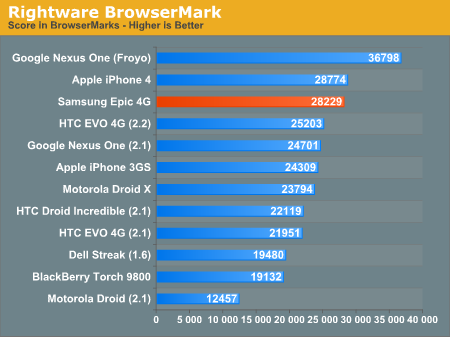
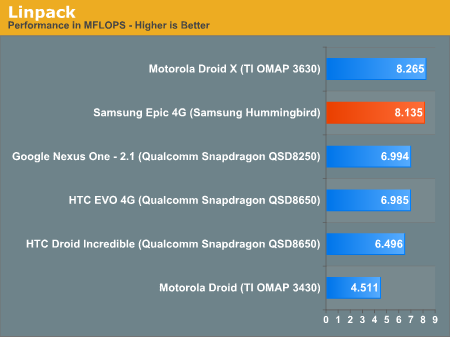
Hummingbird’s memory bus is likely a 32-bit single channel LPDDR1 interface, but overall I’d say it’s safe to say that this is the fastest SoC currently shipping in a smartphone. Apple’s A4 used in the iPhone doesn’t run at 1GHz, and TI’s OMAP3630 uses the PowerVR SGX 530 compared to Samsung’s SGX 540. Unfortunately much of the performance advantage will go unused as 3D gaming simply isn’t that prevalent on Android phones today.










93 Comments
View All Comments
MJinZ - Monday, September 6, 2010 - link
It's an interesting review since it starts out with some good words and ends with, what my impression is - well it's a POS.And I'm sorry Samsung, but a phone needs to last more than 5 minutes and a GPS needs to work. We really could not care about it looking like a damn iPhone. Hell, people buy iPhones for that.
Try harder Sammy.
zizagoo - Monday, September 6, 2010 - link
There seems to be an agreement amongst high-end Android users that battery life is terrible within the first two weeks, but then significantly improves after the battery has been conditioned. It's possible that due to the short review period, this never get's a chance to happen, causing an under report of the battery life.It would be fascinating if you did a follow up later on to determine if this is true.
StealthX32 - Monday, September 6, 2010 - link
The functional battery life is pretty long. I can pull 1.5-2 days if my use is limited (maybe 20 minutes of calling, 20 or so text messages, little to no browsing). The Hummingbird really does sip power when it's idle.If you're hammering away at it for 4 straight hours, then the battery life is pretty poor.
strikeback03 - Tuesday, September 7, 2010 - link
But other than emergency situations, are you really going to have a phone like this and only use it that little? I've mentioned before, I wish they could come up with some type of "real-life" battery test that would include a certain amount of talk, text, web, video, etc. per hour. For example, I would be surprised if the battery in my HTC Diamond lasts much more than 2 hrs in 3G browsing, but in my usual day (5-10 min talk, 80-100 text, few MMS, 10-15 min web, many times turned on to check the time) it generally has 20-30% still showing when I put it back on the charger after 15-16 hrs.Dane74 - Monday, September 6, 2010 - link
On battery break in: with Lithium based batteries, break in is negligible. The observed better second week battery life comes from playing with less features.I expected better battery life than my spouse's Evo, due to more efficient power usage of the Epic's processor as well as its screen. We found the battery life to be equal, my impression from behavior of both in weak signal areas is that Epic's voice, 3g and its 4G reception is slightly worse than Evo which will cause some additional drain on power.
gvaley - Tuesday, September 7, 2010 - link
My personal experience (6+ device batteries so far, including phones, cameras) shows a 1,8-2x battery life improvement after 3-4 charge-discharge cycles. And it's definitely not due to unbalanced usage. The same holds true for both Lithium-Ion and Lithium-Polymer batteries, although the more I think about it, the more I convince myself that Lithium-Polymer are more susceptible to break in.Ratman6161 - Tuesday, September 7, 2010 - link
I've got an original Droid now running Android 2.2. A while back I picked up a couple of spare batteries cheap online. These are identical to the one that came in the phone. When I swapped in one of the new batteries it was showing up as fully charged already. I started rotating the three batteries every Friday to keep approximately equal usage on each one.I never really noticed any difference. Then again I wasn't specifically looking for that and did not do any kind of test.
AdamPflug - Monday, September 6, 2010 - link
I have the Samsung Captivate (not the Epic 4G), but it's still in the galaxy S line. I noticed that I needed at least 3 complete charge/discharge cycles before I got reasonable battery life out of the phone. It wasn't a decrease in usage either, I made sure I kept my usage patterns consistent.My experience with the Captivate now is that I can listen to podcasts all day, read all my work email, do some web browsing, and still have around 60% battery left at 10pm. If they could just fix the GPS issues with a software patch (they say they're going to sometime in September, along with an upgrade to 2.2) the I'll be extremely happy.
Also, I've been pretty happy with the brightness of my Captivate, I wonder if the review took into account the separate brightness settings for the browser app?
Anand Lal Shimpi - Tuesday, September 7, 2010 - link
These results were all recorded after discharging the phone more than 3 times (each test was run multiple times). Note that 4 hours of continuous usage can often times yield a pretty long real world battery life depending on your usage pattern. That being said, a phone that gets 8 hours in our tests will obviously last longer with the same usage pattern. While the Epic 4G's battery life may be sufficient, it's lower than we'd like to see for a modern smartphone.And thank you for the correction on the browser brightness setting, that's why the screen looked dimmer at full brightness by comparison. In that shot the Epic 4G's screen was set to approximately 20% brightness. I've made the appropriate correction in the review and credited you with the heads up :)
Take care,
Anand
gvaley - Tuesday, September 7, 2010 - link
Anand, the poor battery life is probably due to Sprint. Other reviews (of the European 3G galaxy S) show maybe the best battery life among Androids. Check this test from a very reputable site: http://blog.gsmarena.com/samsung-i9000-galaxy-s-fu...